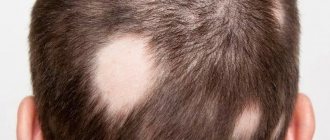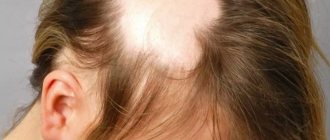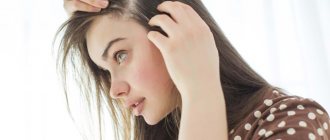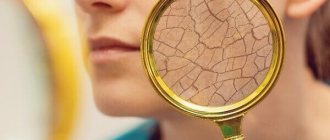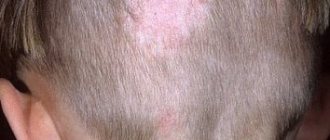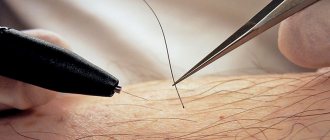Quick Transition Treatment of Androgenetic Alopecia
Androgenetic alopecia (AGA) or androgen-dependent hair loss (androgenetic alopecia) is hair loss with a typical distribution of male or female pattern* (male pattern hair loss MPFH or female pattern hair loss, FPHL).
* This term is proposed to be used in the new revision of the ICD.
Androgenetic alopecia is thinning and hair loss, and subsequently the formation of bald spots in characteristic areas of the scalp.
The condition is androgen-dependent and occurs in individuals with a genetic predisposition. Under the influence of male sex hormones androgens, hair follicles in sensitive areas gradually decrease in size (miniaturize), and hair falls out.
Normally, androgens are also produced in the body of healthy women, but in smaller quantities than in men.
Androgenetic alopecia is the most common form of hair loss in men (affecting approximately 50%). AGA occurs in women over 40 years of age, increases significantly after menopause, and can affect up to 75% of women over 65 years of age.
The process develops over years, gradually affecting an increasing number of follicles and becoming more pronounced with age.
Typically begins before the age of 40.
Androgenetic alopecia - symptoms and treatment
Androgenetic alopecia is a commonly diagnosed type of baldness that affects 75% of men and 45% of women. The disease is a consequence of hormonal disorders, develops over the years, and is often inherited. At the initial stages of development, the symptoms are subtle, but as they progress, the amount of hair rapidly decreases, especially in the middle of the parting, on the crown, and in the temporal zone. Hair follicles are negatively affected by the specific male hormone dihydrotestosterone (DHT), which is transformed from testosterone. If a hormonal imbalance occurs in the body, the production of DHT increases, as a result, the hair follicles do not receive enough nutrients, regenerate worse and gradually die, and the hair rapidly thins out. Trichologists at the International Hemostasis Clinic will help you find out the causes of androgenetic alopecia and select effective treatment that will help restore the health of your hair.
Hair growth phases
Each hair goes through three phases in its development3:
- Anagen is the most active phase in which hair growth begins9.
- Catagen is a transition period9, which is characterized by the cessation of protein production in the hair9 and the cessation of its growth3. At this stage, the size of the follicle decreases to 70%9, and it goes into hibernation.
- Telogen - during the resting phase, the hair separates from the root and falls out, after which the follicle prepares to form a new one3. Normally, there are 100-150 thousand follicles on the scalp: 85% are in the anagen phase, 14% in telogen and only 1% in catagen3,9. In other words, the normal quantitative ratio of hair in the anagen and telogen stages is 9:14. With AGA, this ratio changes - the growth phase is shortened and the amount of hair at rest increases4. It is believed that this occurs under the influence of androgens. It has been experimentally proven that they are able to block the production of certain growth factors in anagen4.
What is androgenetic alopecia
Androgenic hair loss is a hereditary disease that can be caused by a number of factors:
- increased content of the male sex hormone dihydrotestosterone inside the hair follicle;
- pathological sensitivity of hair follicles to DHT;
- excessive activity of the enzyme 5α-reductase, which converts the hormone testosterone into dihydrotestosterone.
A specific form of the male hormone dihydrotestosterone, having penetrated the cells of the hair follicles, destroys them from the inside. This leads to weakening, dullness and hair loss. If the diagnosis and treatment of the pathology is not timely, a bald spot will soon form on the head, visible to the naked eye.
Dihydrotestosterone is present in both men and women, so androgenetic alopecia is diagnosed in both sexes. However, in women, the disease is easier to treat and the symptoms are less severe. This is due to the fact that in the female body there are much fewer androgen receptors; in addition, women synthesize the aromatase enzyme in large quantities, which converts DHT back into testosterone and estrogen.
Hair treatment with Laennec 2ml RUB 4,500. Hair mesotherapy with Curacen 2 ml RUB 7,000. Hair mesotherapy with F-hair men 5 ml 4,000 rub.
All prices Make an appointment
New aspects of the pathobiology of androgenetic alopecia
The search for mechanisms regulating the activation and progressive development of AGA continues. Oxidative stress has been found to be an important contributing factor to hair loss.
Compared with cells taken from a non-balding area at the back of the head, dermal papilla cells from a male balding area were significantly more sensitive to oxidative stress. They were also characterized by reduced proliferation and migration, accompanied by an increase in the level of reactive oxygen species and aging.
AGA – a marker of aging?
Some experts consider AGA as an organ-specific segmental accelerated aging with increased sensitivity of hair follicle fibroblasts to oxidative stress.
Particular attention has recently been paid to the role of additional organs located in close proximity to the hair follicle. The levator pili muscle has been identified as a new participant in the pathogenesis of AGA.
It has been hypothesized that loss of the connection between the levator pili muscle and the follicular unit drives the process of miniaturization in AGA and leads to its irreversibility, in contrast to the reversible process observed in alopecia areata, in which the connection between the muscle and the follicular unit is preserved.
| Androgenetic alopecia. Hypothesis It has been proposed that the levator pili muscle is replaced by adipose tissue, a phenomenon that may lead to depletion of stem or progenitor cells in the follicle mesenchyme. |
the sebaceous glands have been put forward as potential factors in the pathology of AGA.
. It has been shown that in patients with AGA there is a significant increase in the area of the sebaceous glands with a simultaneous increase in the number of lobes in each follicular unit. It has been suggested that the close relationship between DHT and the functional activity of the sebaceous gland leads to their expansion, which may provoke an early transition to the catagen or telogen phase.
Androgen-dependent processes in target tissues occur primarily due to the
binding of DHT to
AR .
DHT-dependent cell functions are determined by the presence of weak androgens, their conversion to more powerful androgens under the action of 5-alpha reductase, low enzymatic activity of androgen-deactivating enzymes, and the presence of large quantities of functionally active AR.
High levels of DHT and increased expression of AR were recorded on the disease-prone scalp.
The conversion of testosterone to DHT in the dermal papilla plays a key role, while androgen-regulated factors produced by the cells of the dermal papilla presumably influence the growth of other components of the HF.
Only in some women with AGA is the presence of pathological changes in androgen metabolism confirmed in the peripheral blood serum, and deviations from the norm are often insignificant. According to research by Moltz, in 125 women with AGA, an increase in free testosterone levels was found in only 29%.
In AGA, endocrine disorders on the other side of the androgenic horizon are described, characterized by prolactinemia, disruption of thyroid-stimulating hormone (TSH), melatonin, and somatotropin. There is a dependence associated with a decrease in serum ferritin levels (< 30 ng/ml).
Despite the variety of described hyperandrogenic conditions, more often AGA, both in women and men, occurs against the background of normal androgen levels and is not accompanied by any endocrine disorders, the so-called receptor form.
Correlations
Research published over the past few years has further strengthened the association between AGA and the risk of cardiovascular disease and metabolic syndrome. It is separately emphasized that these diseases are more consistent with early-onset AGA, affecting the vertex area.
According to the data obtained, inflammatory markers such as fibrinogen, C-reactive protein and lipoprotein (a) were risk factors for cardiovascular diseases in AGA. AGA has also been shown to be associated with increased arterial stiffness, even in asymptomatic young adults.
In addition, AGA has been demonstrated to be an independent predictor of mortality from diabetes mellitus and cardiovascular disease.
The link between AGA and benign prostatic hyperplasia (BPH) has also been strengthened. It has been shown that patients suffering from BPH with inflammation of the prostate gland are characterized by a higher severity of AGA.
A connection was also found between BPH, AGA and AR gene polymorphism (SNP rs6152 G>A).
According to a recent meta-analysis, vertex distribution of AGA is associated with a significant increase in the risk of prostate cancer, while other types of AGA distribution do not have a significant increase in the risk of prostate cancer.
Risk factors
The risk group includes men and women with a hereditary predisposition to androgenic alopecia. In this case, the trigger for the progression of the disease can be negative internal and external factors, such as various chronic, autoimmune, infectious diseases, unhealthy diet, abuse of bad habits, stress, tumors of benign or malignant etiology.
Hormonal imbalances and the negative impact of pathological factors cause androgen deficiency, in which testosterone is converted to dihydrotestosterone. This hormone negatively affects hair growth and regeneration. Its accumulation in hair follicles contributes to impaired blood circulation and nutrition, and then to destruction and death. As degenerative processes progress, signs of alopecia become more pronounced
EPILOGUE
In conclusion, I would like to place special emphasis on two aspects.
Firstly, the use of all of the above treatment methods does not change the genetic program of the hair follicles, therefore the therapeutic successes of these measures are temporary and should be repeated regularly throughout the patient’s life. It is also necessary to exclude internal factors (for example, iron deficiency anemia, endocrine diseases, etc.), which, together with AGA, worsen the condition of the hair and lead to chronic diffuse thinning.
Secondly, for skeptics, we note that the innovative DECOPILL passed strict dermatological control in clinics in Europe and the USA, while demonstrating its effectiveness and safety as a result of clinical tests, which objectively revealed:
- activation of hair growth by 121%,
- significant delay in hair aging by 46%,
- improvement in encoring (fixation in the skin) of the hair shaft by 73%.
Symptoms of androgenetic alopecia
At the initial stage of development, the disease proceeds unnoticed, so diagnosing the pathology in the early stages of progression is problematic. The following symptoms should alert you:
- thinning, abnormal hair loss;
- a large number of split ends;
- fading, deterioration of color, loss of volume;
- slow growth of new hair shafts.
As the disease progresses, noticeable thinning is observed in the parting area and in the temporal zone. With severe hormonal imbalance, in addition to hair loss on the head, thinning eyelashes and eyebrows are observed.
Hair treatments do not help cope with the problem. The scalp becomes oily, prone to irritation and inflammatory rashes. I am constantly worried about oily dandruff, which is not treated with the usual antifungal shampoos.
EFFECTIVE REMEDY FOR CORRECTION OF ALOPECIA
DECOPILL™ is the latest patented natural bioactive peptide complex with vitamins, amino acids and ozonides, designed to slow down the process of pathological hair loss, tested and shown clinically significant results in protecting and restoring follicles, as well as improving hair structure and health.
DECOPILL™ is intended to eliminate the main symptoms of pathological hair loss of most known alopecias. The main result of its action is to prolong the hair growth phase and improve resistance to the harmful effects of DHT, as well as to increase blood circulation, enhance vitamin nutrition of the hair roots and scalp surface, as a result of which the aging process of the follicles slows down.
The creators of the drug spent 10 years on development and clinical trials, which showed that the effects of alopecia correction are reliably recorded within 30–90 days from the start of complex treatment.
Rapid reduction in the amount of hair loss (after a 30-day course).
Activation of latent existing hair (from 0 to 3 mm after a 90-day course).
Causes of androgenic alopecia
Androgenic alopecia is a consequence of a hormonal disorder in which the amount of androgens in the body increases. The following negative exogenous and endogenous factors can trigger the mechanism of baldness:
- Hereditary predisposition. The tendency to androgenic alopecia is transmitted at the genetic level, both on the maternal and paternal lines.
- Hormonal changes. During puberty, pregnancy, and breastfeeding, the synthesis of androgens increases, but as soon as the hormonal levels stabilize, the problem of hair loss will resolve itself.
- Endocrine disruptions. Diabetes mellitus, benign or malignant tumors localized in the adrenal glands, polycystic ovary syndrome, pituitary hyperplasia, thyroid disease negatively affect the condition of the hair follicles, disrupting their nutrition and oxygen supply, leading to destruction.
- Taking certain groups of medications. Contraceptives, glucocorticosteroids, antidepressants, potent antibiotics, diuretics, anticoagulants, anticonvulsants, if used uncontrolled, can cause damage and death of hair follicles.
- Autoimmune diseases. Autoimmune diseases often cause alopecia areata. The most common include systemic lupus erythematosus, rheumatoid arthritis, scleroderma, and trieoiditis.
- Abuse of bad habits. Alcoholic drinks and cigarette smoke poison the body, disrupt the process of assimilation of nutrients, weaken the immune system, lead to disruption of the functioning of organs and systems, weaken hair, which stops growing and begins to rapidly thin out.
- Strict diets, unbalanced nutrition. With a poor diet, the human body does not receive enough necessary nutrients, vitamins, micro- and macroelements. This leads to weakened immunity and hormonal dysfunction, which negatively affects the condition of the hair.
- Stress. Chronic stressful situations negatively affect the functioning of organs and systems, leading to serious illnesses and hair loss. After such emotional overload, the curls thin out, become dull, and stop growing in length.
- Unbalanced diet. Deficiency of vitamins, nutrients, micro- and macroelements contribute to a decrease in the body's defenses and weakening of hair follicles, which become thinner and die over time.
Causes of baldness and their diagnosis
Let's take a closer look at the factors that can serve as an impetus for the appearance of the disorder: ● genetic; ● psychological; ● disorders of the peripheral nervous system; ● autoimmune; ● various disorders of the endocrine system.
As you can see, there can be a huge number of factors, and some of them are treatable, and some, alas, are not.
Genetic predisposition has not yet been treated. Although other sources can be overcome, it is a long and labor-intensive process. For example, bringing your psychological state back to normal may not be as easy as it seems at first glance. It is not easy to stabilize the immune system, even by taking immunostimulants. In any case, first you need to visit a specialist, take a general blood test and undergo other necessary examinations. They may also take a number of hairs from you for examination under a microscope. Such events can take from several days to a couple of weeks.
Another reason not listed above may be helminthiasis. Therefore, you need to get tested for antibodies to parasites and feces. Because they can take away some of the beneficial micro and macroelements and vitamins that enter your body with food. Accordingly, due to their lack, hair can also become unusable, have a dull appearance, split ends, and also fall out. Moreover, attempts to correct the situation by using rinses, balms, gels, and masks will be reduced to almost zero results. In order to find out what exactly affected your disease, you need to undergo a full and comprehensive examination by different specialists, take tests and undergo diagnostic tests.
Treatment for the development of androgenic hair loss in women will always depend on the factors that caused it. Starting from the genetic predisposition of the body to chemical burns, poisoning, and even helminthiasis. Often the reason for hair loss can be not only a lack of vitamins in the body, but also an excess, including group A. Problems also arise during hormonal imbalances. Excessive body hair, or vice versa, hair loss. For example, during pregnancy, breastfeeding, or while taking oral contraceptives.
Another reason may lie in a lack of iron, zinc in the body, and other nutritional disorders. In particular, baldness can be affected by an unbalanced diet, which adversely affects not only the quality and growth of hair, but also the condition of the entire body as a whole. Therefore, you should not go on a diet on your own and strictly limit the intake of any foods.
Also, an aspect that influences the appearance of alopecia can be cancer. Not only radiation and chemotherapy can help, but also taking other specific drugs and targets. Usually, at the end of treatment, the quality of the strands is restored and their growth resumes.
The psychological state of a woman who is breastfeeding plays a big role in the development of the disease. Everyone knows the fact that many young mothers have postpartum depression. It is not always easy to identify, since a person can keep problems to himself and not express emotions outward. In this case, professional consultation with a psychologist is recommended.
An important component in treatment is timely and correct diagnosis. After all, if you quickly get rid of the root cause, then perhaps the hairs will begin to grow back on their own, without outside help. Otherwise, you may even need a transplant from another part of the head or area of the body with hair.
The question of how to cure androgenetic alopecia in women worries many who are faced with the problem. Do not despair and give up - this type of disease can be successfully treated. The article is devoted specifically to female pattern baldness, which often occurs against the background of disturbances in the level of hormones in the body. In particular, increasing the level of androgens. They are produced in the female half of the population and even in children. Their action occurs through the cells of the hair papilla, where they bind to the corresponding receptor and influence the occurrence of paracrine factors. But there may be a violation of the control of their release in the body. There may be many reasons for this, as mentioned above.
Types of androgenic alopecia
In women and men, the course of the disease and clinical symptoms at different stages of development are different. The pathology is mainly diagnosed in men; the first signs appear at the age of 30–35 years.
Androgenetic alopecia in women
In women, the disease is less severe than in men. The problem mainly worsens during puberty, pregnancy, breastfeeding, and also during the premenopausal period.
In women, there are 3 forms of androgenetic alopecia:
- I-shaped, like a strip. The density of the hair decreases along the central parting. Gradually, the thinning area spreads closer to the temporal zone.
- O-shaped. Hair loss also begins from the parting area, but the dying off of the hair follicles is observed in the parietal and frontal areas. Due to this, foci of baldness simultaneously spread to the forehead and back of the head, forming a large lesion, shaped like a round nest.
- Male pattern baldness. This type of androgenetic alopecia in women is rarely diagnosed, but progresses very quickly. In the frontal and parietal region, the hair becomes thinner and falls out, resulting in the formation of a bald spot similar to a man's.
Introduction
Androgenetic alopecia (AGA)
is a complex polygenic multifactorial condition that is the most common form of hair loss, affecting up to 80% of men and 50% of women during their lifetime. AGA develops over the years and is a reflection of segmental or organ-specific premature aging.
Genetic studies of this disease have once again highlighted the role of inheritance
. In this regard, a recent analysis of published genetic studies of AGA revealed a novel association of AGA and rs7349332, located in the intronic region of WNT10A, thereby suggesting the involvement of WNT signaling in the etiology of AGA. In a German case-control study of AGA, it was shown that one of the reasons for the genetic risk of developing AGA is a pronounced polygenic component. This fact likely reflects the complexity of the biological pathways associated with AGA.
Genetic testing
Currently, it is believed that AGA is a genetically multifactorial trait with a complex genetic structure.
The "usual suspect" gene on the "androgen side" in this case is the androgen receptor gene ( AR
), which is located on chromosome X, which may explain maternal transmission of AGA.
It is still unclear which genes other than AR
are responsible for AGA. Patients should be aware that current genetic testing is based on AR gene variations, when in fact the onset of androgenetic alopecia is caused by polygenic involvement of other genes or epigenetic mechanisms
Clinical phenomenology
AGA is a continuous, protracted process rather than a series of distinct disease phases, and each patient is characterized by a wide range of different features. As AGA progresses, it behaves similarly to the process of tissue aging - in the hair follicles, as in other organs, the proportion of cells that have only a structural function increases, sutures, constrictions, scars are formed, sclerosis occurs - increased development of connective tissue components, which leads to the weakening of specific functions, thinning and hair loss
Backward displacement of the frontal growth line and baldness of the crown are the main signs of male androgenetic alopecia. In addition, areas of alopecia may merge into a single whole, leaving only a border of normal hair growth on the sides and back of the scalp.
AGA in women progresses more slowly, is less severe, and demonstrates greater variability in response to therapy.
In women, there are three different models of AGA:
- diffuse thinning of the crown area while maintaining the frontal hairline (Ludwig model
);
- thinning and spread to the central part of the scalp with disruption of the frontal hairline (christmas tree model
);
- thinning associated with bitemporal bald patches (Hamilton model
), more often observed in menopausal women and in women with hyperandrogenism.
Androgenetic alopecia syndromes
In rare cases, extremely severe androgenetic alopecia or its early onset may be a symptom of a complex genetic disorder, such as
- trichorinophalangeal syndrome;
- progeria;
- Laron syndrome;
- and Kurshman-Steinert-Batten myotonic dystrophy.
Premature baldness
Androgenetic alopecia, the clinical signs of which appear between the ages of 10 and 20 years, is called premature or early baldness. In children before puberty, the disease, in both boys and girls, manifests itself exclusively as female pattern baldness.
Differential diagnosis of congenital hair loss includes:
- simple hypotrichosis;
- and ectodermal dysplasia (with concomitant delay in physical/mental development, sweating, abnormalities of nails and teeth).
Evolution of classifications
Determining the severity of androgenetic alopecia is challenging.
The top row shows four drawings carved on the walls of a primitive cave. It took about 30 thousand years to classify the pattern of hair loss in men, shown in the bottom row. Currently, various classification methods have been developed and modified.
AGA classifications
Until recently, the generally accepted standard was the Hamilton-Norwood classification
(1951-1975) for men and
Ludwig's classification
(1977) for women, emphasizing gender heterogeneity.
Evolution or revolution?
There was a need to improve existing classifications, as a result of which a universal classification was created in 2007. In 2007, Lee et al. proposed the basic and specific (BASP) classification system, which is an improved version of the Norwood-Hamilton classification, including four basic types (L, M, C, U) and two specific types (F and V).
| Basic and specific (BASP) classification for pattern hair loss (From: Lee WS, Ro BI, Hong SP et al (2007) A new classification of pattern hair loss that is universal for men and women: basic and specific (BASP) classification. J Am Acad Dermatol 57(1):37–46) |
The new classification of typical hair loss is a universal tool used for both men and women: the basic and specific (BASP) classification.
It can be used to assess both the further extent of hair loss and the response to therapy. By improving on the shortcomings of existing classifications, it is easier to remember and easier to apply in clinical settings. The Norwood-Hamilton classification does not take into account some specific types of hair loss, such as female pattern hair loss.
Additionally, the Ludwig scale cannot be used to classify male pattern baldness in women. BASP, regardless of gender or race, allows you to classify all varieties of hair loss types.
Reasons for the development of AGA
The development of AGA is based on gender homogeneity, which is associated with the genetic characteristics of androgen metabolism in the hair follicle.
The most significant factor in men is increased activity of the enzyme 5-alpha reductase type II, which metabolizes testicular testosterone into dihydrotestosterone (DHT) in genetically predisposed hair follicles.
In women, as a rule, a major role is played by a decrease in the activity of aromatase, which converts ovarian testosterone circulating in the blood into 17 beta-estradiol.
An increase in local DHT concentration leads to a progressive reduction in anaphase due to a longer telogen phase and is accompanied by progressive miniaturization of the HF. Miniaturization of the HF is carried out due to relatively sharp reductions in the number of cells of the dermal papilla and dermal membrane. Accompanied by:
- reduction in the absolute number of VF,
- a decrease in the period of anaphase,
- rod diameter,
- as well as increasing the duration of the kenogen phase.
The role of perifollicular inflammation
In addition to androgen-dependent changes in the pathogenesis of AGA, the involvement of follicular microinflammation with the formation of fibrosis, provoked by the presence of bacterial flora, toxins and oxidative stress, has been proven.
Androgenic type of alopecia in men
In men, androgenetic alopecia is classified according to the Norwood scale, which distinguishes 7 stages of baldness:
- First. There is a barely noticeable deviation of the front hairline back in the forehead and temples.
- Second. The depression in the temporal and frontal zones takes the shape of a triangle, hair loss on both sides is symmetrical. Alopecia spreads up to 2 cm deep. Thinning is also observed in the parietal region.
- Third. The triangular depression in the frontotemporal region exceeds 2 cm. There is a pronounced thinning of vegetation on the crown.
- Fourth. Hair loss increases in the frontal region and on the crown. The affected areas are separated from each other by a clear zone of hairs of normal structure and density.
- Fifth. Rapid baldness in the frontal area and on the crown continues, the bridge noticeably decreases in size.
- Sixth. The temporo-frontal zone and the thinned crown merge, the defect extends to the occipital part.
- Seventh. Hair is preserved only in the back of the head and in front, near the ears.
Treatment of alopecia
There are several ways to treat alopecia, as well as its types. So, in some cases, it is first necessary to eliminate the cause, for example, an infectious disease or a lack of vitamins and minerals. In this case, treatment is prescribed by a gynecologist, endocrinologist and other specialists.
Treatment is possible through the use of medications, vitamin-mineral complexes, ointments, solutions, as well as various cosmetics and procedures.
With the help of competent and correctly prescribed treatment, it is possible to slow down the process of baldness, and in some cases, stop it completely. If treatment is impossible, which, although rare, does happen, then there is a way out - in modern medicine, hair transplantation is widespread and successfully used, which, by the way, has become quite affordable and gentle.
Diagnostics
Before starting treatment for androgenetic alopecia, it is necessary to establish an accurate diagnosis and find out the reasons for the progression of the pathology. A trichologist diagnoses and treats all forms of baldness. After the initial examination, the doctor will give a referral for a comprehensive diagnosis, including laboratory and instrumental examination methods:
- trichogramma;
- phototrichogram;
- general clinical and biochemical blood test;
- laboratory blood test for hormones of the reproductive system of the thyroid gland.
How to diagnose AGA?
According to the observations of trichologists, today androgenetic alopecia occurs in almost every second person, it just can manifest itself at different speeds and intensity. Therefore, you should carefully monitor the condition of your hair so as not to miss the onset of AGA.
How to diagnose AGA? A blood test will not give a result, since hormones and other indicators in AGA may be normal, and in more than 50% of cases, AGA occurs against the background of absolute health of the body. We remind you that the question is not about hormones as such, but about the degree of sensitivity of the follicles to them. Therefore, the best diagnosis is an examination by an experienced trichologist, trichoscopy and phototrichogram.
Drug therapy
Drug treatment of androgenetic alopecia involves the use of the following groups of drugs:
- dihydrotestosterone blockers;
- vitamin and mineral complexes;
- oral contraceptives that normalize hormonal levels in women;
- sedatives;
- antidepressants.
For external use, the following agents are additionally prescribed:
- hair growth stimulants in the form of lotions, sprays, masks;
- antiandrogens in the form of ointments, creams;
- copper peptides in the form of shampoos, conditioners, sprays.
Replacement using our method
This technique allows you to mask problem areas of the scalp while treating the disease. And this can be done with a special base, which is fixed to problem areas. Hair is attached to this base, which can be wetted, dried and styled with special styling products.
Replacement is a modern method of hair replacement. Ideal for those who want to look good, regardless of the disease.
- Alopecia in women
- Diffuse alopecia in women
- Hormonal alopecia in women
- Alopecia areata in women
- Seborrheic alopecia in women
- Alopecia areata in women
- Baldness in women
- Types of female pattern baldness
- Treatment of androgenic hair loss in women
Features of treatment for men with androgenetic alopecia
When treating this type of baldness in men, medications that completely suppress testosterone synthesis are not prescribed. Otherwise, it will lead to the manifestation of female sexual characteristics.
The doctor individually selects medications for the man that suppress the activity of androgens. Minoxidil has proven itself well. After just 2 months of regular use of the solution, new hairs begin to grow on the head. After 8 months the drug reaches its peak effect.
Another effective drug for combating male androgenetic alopecia is Finasteride. The medication is taken orally, under the strict supervision of a doctor. Since the drug negatively affects potency, drugs that stimulate sexual activity are prescribed simultaneously with it.
Are there differences in the treatment of AGA in men and women?
For drug treatment of androgenetic alopecia, topical and oral medications are prescribed5. Minoxidil in the form of a solution or foam can be used to restore hair growth in men and women9.
Minoxidil is the first FDA-approved drug for the treatment of androgenetic alopecia8. It increases blood circulation to the hair follicle and stimulates hair growth6.
Minoxidil 5% is contained in REGAIN® in a convenient foam dosage form6. REGAIN® is an original drug. Its effectiveness and high safety profile have been confirmed by clinical studies10,11,12,13. It is indicated for the treatment of AGA in the initial and moderate stages7.
The daily dosage of REGAIN® for men and women is different7, according to the instructions for medical use:
- Men should use 1 g (half a cap) twice daily. One package is enough for a month of use.
- Women only need to use 1 g of foam once a day. A package usually lasts for 2 months.
With regular use of REGAIN®, hair growth restoration can be observed after 2-4 months in men and after 3-6 months in women6. It is important to remember that you should not take breaks in treatment - continuous use of the drug is required to maintain the result of treatment6.
Hair loss entails psychological discomfort, impedes social activity and impairs quality of life1. The first manifestations of androgenetic alopecia can be detected in men and women during adolescence5,6. But more often, men notice signs of AGA closer to 20 years of age, and women at 305. To stop baldness and resume hair growth, treatment should begin as early as possible.
Drugs against androgenetic alopecia
To combat androgenic alopecia, the following drugs are most often used:
- "Finaseride". Antitumor hormonal agent, produced in the form of tablets for oral use. The drug slows down the action of 5α-reductase, due to which the synthesis of dehydrotestosterone is suppressed.
- "Minoxidil." A product for external use, stops the process of hair loss, stimulates the growth and regeneration of new hair. After application to the scalp, the drug activates blood circulation, thereby improving nutrition and oxygen supply to the hair follicles. With regular use, the cells of the hair follicles regenerate, which has a beneficial effect on the growth and condition of the hair.
- "Spironolactone". A potassium-sparing diuretic that reduces the volume of fluid in the body, compensates for the lack of calcium, and normalizes the production of hormones. When treating androgenic alopecia, it slows down the synthesis of androgens in the adrenal glands, blocking their action.
- Cyproterone acetate. Reduces the activity of androgens in the body.
- Estrogen and progesterone. Specific sex hormones that are prescribed to women experiencing their deficiency.
Options and order of therapy for AGA.
1.
Detection of hyperandrogenism and, if present, its correction. This will require the participation of a gynecologist-endocrinologist, since the most common cause is polycystic ovary syndrome. However, we remember that hormones may be normal.
2.
Protection of hair follicles from the destructive effects of dihydrotestosterone (blocking the enzyme 5-alpha reductase). Important! What helps men (usually prescribed finasteride) does not help women! In the treatment of AGA in women, spironolactone (veroshpiron) has proven itself to be effective - it is a potassium- and magnesium-sparing diuretic with a good ability to block 5-alpha reductase. Diane-35 is also often prescribed, which is also used as an oral contraceptive - here you need to look individually at whether this treatment method is right for you. Herbal products can help - zinc, vitamin B6, dwarf palm fruit extract.
3.
Therapy for AGA must necessarily include the prevention and treatment of fibrosis, since with AGA chronic inflammation develops inside the follicles. As a result of inflammation, the connective tissue grows and microscars appear on the scalp. The scalp becomes inactive, rough, the skin is thick and dense. To begin high-quality hair restoration therapy, anti-inflammatory therapy and the fight against fibrosis are a necessary step. At home, these include peelings with acids, the use of anti-inflammatory drugs in the form of special shampoos, masks and lotions. In clinics, this also includes physical therapy using ultrasound, laser, electropheresis and other procedures.
4.
Unblocking non-functioning follicles - using hair growth stimulants. Minoxidil is usually prescribed, but it has long been known about a large number of side effects and contraindications for this drug: pronounced withdrawal syndrome, complications from the cardiovascular system, frequent itching and irritation of the scalp. Many trichologists say that the inclusion of minoxidil in the treatment regimen for AGA is no longer relevant today. Significantly more effective means, including external ones, with amino acids, peptides, zinc, estrogens, herbs, plant extracts, as well as the use of plasma therapy, ozone therapy, mesotherapy, exposure to a fractional apparatus, trichological massage. The best effect is achieved by combining several techniques.
5.
Creating the necessary conditions for hair growth and restoration - eliminating the deficiency of microelements, ensuring high-quality blood supply. This is very important, since hair follicles are extremely sensitive to these two factors. In conclusion, we would like to add that only an experienced trichologist should diagnose AGA and prescribe specific treatment. Therefore, if you are concerned about hair loss, we recommend that you immediately consult a specialist.
LEARN MORE ABOUT HAIRFOOD PRODUCTS
Mesotherapy for androgenetic alopecia
The essence of the technique is the subcutaneous administration of therapeutic cocktails that provide nutrition to the hair follicles and their active restoration. The drug is injected under the skin. Injections are made with special cosmetic syringes equipped with ultra-thin needles, so trauma to the skin is minimal.
The composition of medicinal cocktails includes:
- vitamins;
- microelements;
- antioxidants.
Causes of the disease
There are quite a few reasons, they are determined depending on the type of alopecia.
These may be external factors, the consequences of diseases, deficiencies, as well as heredity. Unfortunately, there are also incompletely studied causes of the disease, but even they are treatable.
Main causes of the disease:
heredity
· deficiency of vitamins, minerals
· postpartum period, lactation period, menopause period
· previous diseases (endocrine, autoimmune, skin)
· intoxication (antibiotics and other medications, chemicals, poisons)
· stress and shock conditions
· antitumor therapies
· injuries (various types of burns, frostbite, wounds)
Hair transplant
Hair transplantation is prescribed to patients for whom conservative treatment methods have not helped to get rid of androgenetic alopecia. For transplantation, one's own viable hair follicles are used, which are surgically transplanted along with pieces of skin. In beauty salons they resort to the following methods of correcting baldness:
- Strip method. Classic transplantation of grafts with hair follicles, which are extracted from the back of the patient’s head. The procedure is traumatic, often accompanied by complications, and after it is performed, scars remain on the skin.
- HFE. A seamless technique, the essence of which is to extract viable hair follicles from the donor area and implant them into problem areas.
Hair transplantation is an effective procedure, the successful implementation of which guarantees maximum effect and complete healing of bald areas.
TREATMENT METHODS
Treatment for AGA primarily aims to increase scalp hair growth and prevent future hair thinning and thinning. In the early stages, it is more effective, since changes in the hair follicles are not irreversible.
There are both therapeutic and surgical methods for restoring hair growth in AGA: taking biological response modifiers, hormonal and non-hormonal antiandrogens, 5α-reductase blockers and hair transplantation.
Thus, an example of pathogenetic means of treating AGA are herbal preparations obtained from olive leaves, extracts from burdock root, stinging nettle, and in women - some oral contraceptives and spironolactone.
A radical method of hair restoration for AGA is transplantation of one's own hair follicles. The principle of surgical treatment is to move androgen-independent terminal hair follicles from the occipital zone, which is not subject to baldness, to areas of androgen-dependent thinning. Hair transplant is a successful treatment method for AGA with long-term results. However, the natural progression of hair loss will continue and subsequent transplants may be required to ensure that the transplanted area is not surrounded by hairless skin.
Among the external methods for correcting AGA, we mention the classic minoxidil and three-phase complexes that have become popular in the last decade, containing the “golden trinity”: the vasodilator epigenin, tripeptide hair growth factor and oleanolic acid. The latter is especially important in AGA, as it inhibits 5α-reductase. These means are used in different schemes depending on the stage of the process. One of the most therapeutically successful representatives of this class of drugs is DEKOPILL™/DEKOPILL™ from the medical company Charismo (Dallas, USA).
